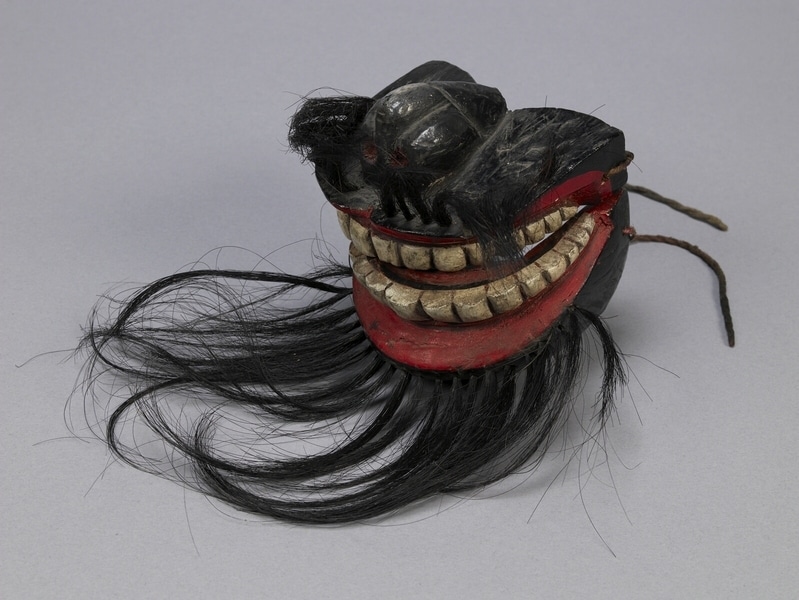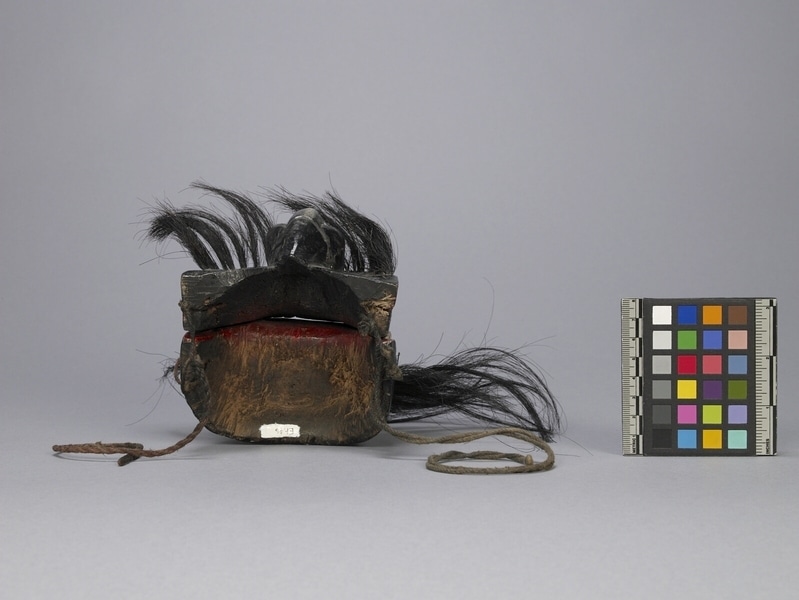Mask Item Number: Eh46 from the MOA: University of British Columbia



Description
A mask consisting of an upper and lower jaw with a nose emerging from the flat top surface of the upper jaw piece. The lips and nostrils are painted red, the teeth are white, and the remainder of the mask is black. The interior is painted red fading to black. Tufts of hair have been inserted above the upper lip, and longer tufts of hair have been inserted just below the lower lip. The upper and lower sections are tied together with string, which also serves as straps at the back.
History Of Use
Worn during curing ritual of the Sanni Yakuma ceremony, part of the Tovil series of dramas performed by Sinhalese ritual specialists and dancers. The Sanni Yakuma is intended to combat diseases and afflictions caused by the Sanni group of demons. These consist of 18 or more apparitions of the chief demon, Maha-kola-sanni. The officiating healer honours Buddha, then appeases the demons with offerings, dancing, and chanting. This mask is probably Maru Sanni, the demon of death which is associated with delirium. It is also used in the Kolam ceremony, a secular form of entertainment, incorporating social satire in dance, mime and music. A purifying demon dance is also included.
Cultural Context
exorcism
Iconographic Meaning
This mask is painted black a colour associated with the most malevolent demons, diseases, moors, other foreigners and wild persons of low social class. The emphasis on a red exaggerated mouth is typical of demon figures. Large white teeth also denote demons.
Item History
- Made in Sri Lanka before 1978
- Collected during 1978
- Owned by Jason Schoonover before February 10, 1981
- Received from Museum of Anthropology Shop Volunteers (Funding source) and Jason Schoonover (Seller) on February 10, 1981
What
- Name
- Mask
- Identification Number
- Eh46
- Type of Item
- mask
- Material
- nux vomica wood ?, synthetic fibre, paint and hair
- Manufacturing Technique
- carved and painted
- Overall
- height 12.5 cm, width 11.5 cm, depth 10.0 cm
Who
- Culture
- Sinhalese
- Previous Owner
- Jason Schoonover
- Received from
- Museum of Anthropology Shop Volunteers (Funding source) and Jason Schoonover (Seller)
Where
- Holding Institution
- MOA: University of British Columbia
- Made in
- Sri Lanka
When
- Creation Date
- before 1978
- Collection Date
- during 1978
- Ownership Date
- before February 10, 1981
- Acquisition Date
- on February 10, 1981
Other
- Condition
- fair
- Current Location
- Case 107
- Accession Number
- 0704/0045